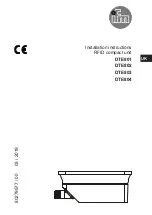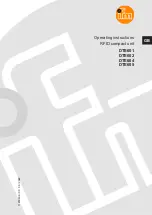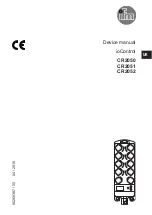
25
PROBABILE CAUSA 4:
4A)
Elettrovalvola controllo discesa rimane chiusa, (vedi fig.
21).
RIMEDIO -
Controllare se l’elettrovalvola è rimasta
chiusa per un guasto meccanico o perché non eccitata
dal magnete. Sostituire le parti guaste.
4B)
Valvola para cadute bloccata, vedi (pos. 22 fig. 24).
RIMEDIO -
Far salire per alcuni centimetri il ponte e
ripetere l’operazione di discesa, se l’inconveniente si
ripete estrarre le valvole paracadute dai pistoni, regi-
strarle con un’apertura compresa tra 0,35-0,40 mm. o
sostituirle se danneggiate.
4C
) Sicurezze meccaniche chiuse a causa del mal funziona-
mento dell’elettrovalvola aria, vedi (pos. 3 fig. 18).
RIMEDIO -
Controllare se l’elettrovalvola aria, sgancio
sicurezze meccaniche, è rimasta chiusa per un guasto
meccanico o perché non eccitata dal magnete. Sostituire
eventuali parti guaste. Controllare che la pressione d’e-
sercizio sia sufficiente “min. 5 bar” (pos. 5-16 fig. 26).
SINTOMO 5
5)
Pulsante di salita premuto il ponte si ferma durante la
salita.
PROBABILE CAUSA 5
5A)
Se con il pulsante giallo di esclusione ed il pulsante di
salita contemporaneamente premuti il ponte si muove:
micro si fine corsa alto guasto o non correttamente posi-
zionato, (pos. 1 fig. 14)
RIMEDIO -
Controllare l’esatta posizione della camma
o la funzionalità del micro. sostituire se ritenuto guasto.
(il micro deve intercettare la camma quando la pedana
si trova ad un’altezza max indicata a FIg. 6, 7, 8).
5B)
Con i pulsanti: giallo di esclusione e di salita, premuti
contemporaneamente, il ponte non si muove.
RIMEDIO -
Controllare i passaggi del punto 1.
SINTOMO 6
6)
Durante la discesa del ponte il segnalatore acustico ini-
zia a segnalare (ma non è ancora arrivato a 30 cm. da
terra).
PROBABILE CAUSA 6:
6A)
Il micro di esclusione fotocellula guasto o non corretta-
mente posizionato. (pos. 2 fig. 11).
RIMEDIO -
Controllare l’esatta posizione della camma
o la funzionalità del micro. Sostituire se ritenuto guasto.
(il micro deve intercettare la camma quando la pedana
si trova a circa 30 cm. da terra).
SINTOMO 7
7) La pedana P1 è a terra mentre la pedana P2 rimane sol-
levata.
PROBABILE CAUSA 7:
7A)
Valvola di livellamento rimane chiusa a causa di: (vedi
fig. 21). Micro di livellamento P1 non correttamente
posizionato. (pos. 5 fig. 11)
RIMEDIO -
Controllare l’esatta posizione del micro sul
suo supporto . Sostituire il micro se ritenuto guasto.
REMEDY - Raise the lift at some centimeters
height and repeat the lowering phase.
If the
problem occurs again, pull the parachute valves out of
the pistons, adjust their opening ranging from 0,35-
0,40 mm. or replace them if damaged.
4C
) The mechanical safeties are closed due to a faulty air
electrovalve (pos. 3 picture18).
REMEDY -
Check whether the air electrovalve, relea-
sing the mechanical safety , is closed because of a
mechanical fault or because it is not excited by the
magnet. Replace the faulty parts. Verify that the
working air pressure is 5 bar min. (pos. 5-16 picture.
26).
SYMPTOM 5
5)
Pulsante di salita premuto il ponte si ferma durante la
salita.
POSSIBLE CAUSE 5
5A)
If pushing both the yellow exclusion button and the lif-
ting button, the lift moves: the lifting limit switch is faulty
or incorrectly positioned (pos. 1 picture 14)
REMEDY -
Check the correct position of the cam and
the functioning of the micro switch . Replace it if faulty.
(The micro should intercept the cam when the pplatform
is at the max. height indicated in pictures 6, 7, 8).
5B)
If pushing both the yellow exclusion button and the lif-
ting button, the lift does not move
REMEDY-
Check the instructions in step 1
SYMPTOM 6
6)
During the lowering phase, the acustic signal starts bee-
ping (but the lift is not at 30 cm from the floor yet).
POSSSIBLE CAUSE 6:
6A)
The microswitch for thr photocell cot out is faulty or
incorrectly positioned. (pos. 2 picture 11).
REMEDY -
Check the correct position of the cam or thr
functioning of the micro. Replace it if faulty. (The micro
should intercept the cam when the platform is at about
30 cm from the floor).
SYMPTOM 7
7) The P1 platform is fully lowered while the P2 platform
remains lifted.
POSSIBLE CAUSE 7:
7A)
The levelling valve remains closed due to : (see picture
21). The P1 levelling microswitch is positioned incorrec-
tly. (pos. 5 picture 11)
REMEDY -
Check the correct position of the miscro-
switch on its support. Replace the micro if faulty.
7B)
The magnet of the levelling valve is not excited.
REMEDY -
Check whether the valve opens by connec-
ting 24V directly on the magnet. Check the functioning
of the electric card and the connection of the cable
between the magnet and the card.
7C)
The levelling valve on the hydraulic block remains closed
(see picture 21)
REMEDY -
Check whether the elkectrovalve is blocked.














































